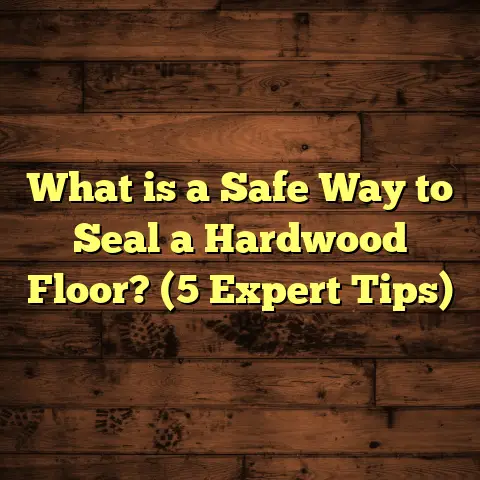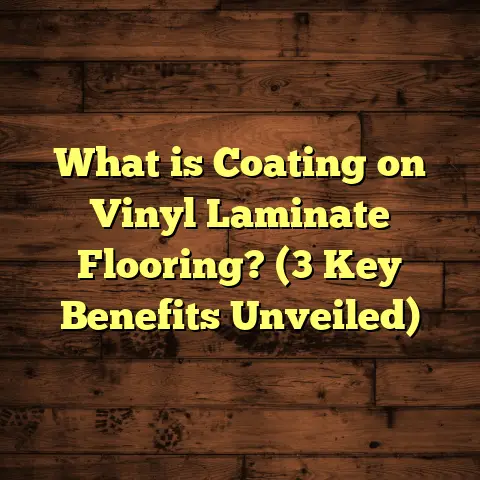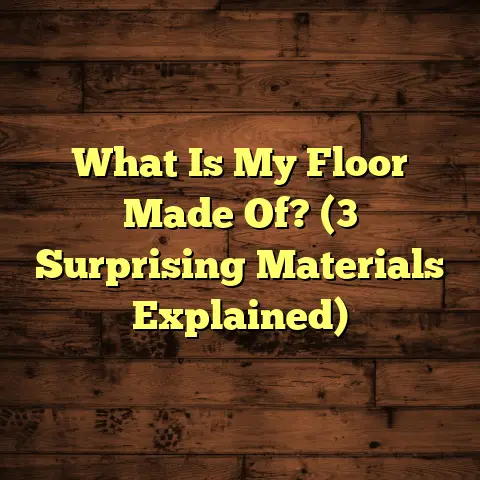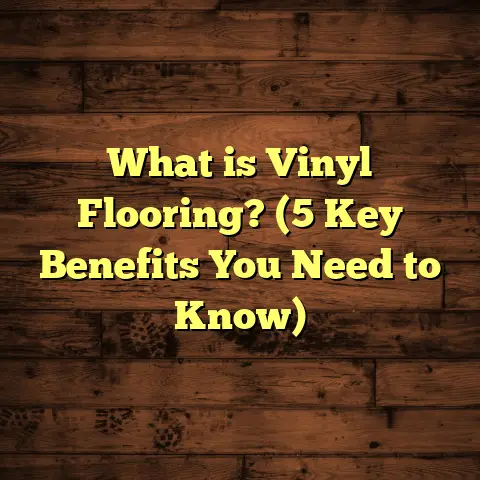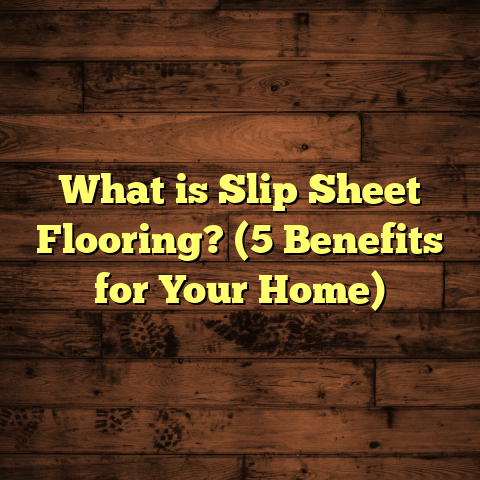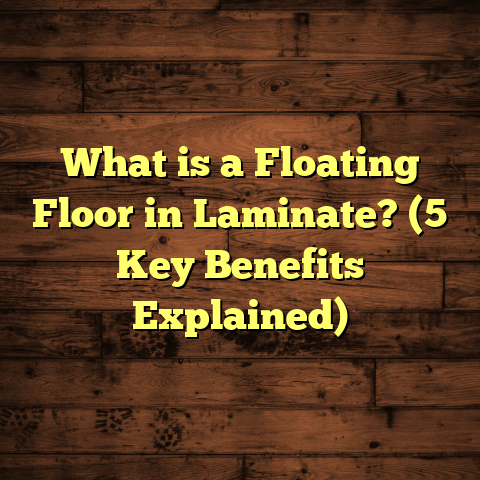What is Textured Vinyl Flooring? (5 Benefits You Didn’t Know)
Textured Vinyl Flooring: What Is It and Why Should You Care?
Hey! Have you ever walked into a room and noticed the floor felt a little different—like it wasn’t just flat but had some subtle bumps or patterns you could actually feel under your feet? That, my friend, might be textured vinyl flooring. I’ve worked with all kinds of floors over the years, but textured vinyl always gets me curious because it’s not just about looks; it’s about how a floor feels, performs, and even protects you in ways you might not expect.
Whether you’re remodeling your home or just curious about flooring options, I want to take you on a journey to understand what textured vinyl flooring really is, why it might be perfect for your space, and some benefits you probably didn’t know. Ready? Let’s get to it.
What is Textured Vinyl Flooring?
At its core, vinyl flooring is a synthetic floor covering made primarily from polyvinyl chloride (PVC). You might have heard of vinyl floors being smooth and shiny or matte. But textured vinyl flooring takes things up a notch by adding an embossed or raised surface that you can feel underfoot.
Unlike flat vinyl sheets or planks, the textured variety has a surface pattern that mimics natural materials like wood grain, stone, or tile grout. This texture isn’t just slapped on top; it’s baked into the material during manufacturing through embossing.
How is Textured Vinyl Made?
Here’s a little peek behind the scenes. During production, the vinyl is layered with a design film that shows the pattern—say a wood grain look. Then an embossing roller impresses the texture onto the surface while the vinyl is still warm and pliable.
This process creates depth—grooves and ridges that reflect light differently from various angles. That’s why textured vinyl can look surprisingly like real hardwood or stone when you see it in person.
Types of Textured Vinyl Flooring
Textured vinyl comes in several formats:
- Sheet Vinyl: Large rolls with embossed textures.
- Luxury Vinyl Tile (LVT): Tiles that often mimic stone or ceramic with textured surfaces.
- Luxury Vinyl Plank (LVP): Planks designed to look like wood with wood grain textures.
I’ve installed all three types and found each has its sweet spot depending on the project needs.
What Makes Textured Vinyl Stand Out?
You might wonder: “Isn’t all vinyl flooring pretty much the same?” That’s a fair question. But when you feel textured vinyl underfoot or see how it performs over time, it becomes clear how much difference surface texture makes.
Let me share some stories and insights that shaped my appreciation for textured vinyl floors.
5 Benefits of Textured Vinyl Flooring You Didn’t Know
1. Slip Resistance That Actually Works
Does your floor feel safe when wet? I’ve seen many homes where slick floors caused slips—especially in areas like bathrooms or kitchens.
Textured vinyl changes the game by creating tiny ridges or grooves that increase grip. According to research by the National Floor Safety Institute, surfaces with texture reduce slip-and-fall accidents by nearly 40% compared to smooth floors.
In one project, I installed textured LVP in a daycare center where kids often spilled water. The floor held up beautifully, and parents appreciated the added safety. The texture made a big difference—they could see it and feel it.
Slip resistance is not just about safety but peace of mind. Whether you have kids, elderly family members, or pets, textured floors help prevent accidents before they happen.
2. Durability That Stands Up to Life’s Messes
Vinyl floors are known for durability, but texture adds another layer of protection by camouflaging scratches and scuffs. The patterned surface breaks up light reflections that would otherwise highlight wear marks.
I remember a client with an active dog who worried about claw marks ruining her floors. We went with textured vinyl with a wood grain finish. Months later, her floors looked almost new—even though her dog ran around constantly.
Textured vinyl also resists dents better than some softer flooring types because the embossing adds thickness and strength to the wear layer.
3. Looks That Mimic Natural Materials
If you love the look of hardwood or stone but hate their cost or maintenance demands, textured vinyl is a dream come true.
I was skeptical at first when I saw some vinyl samples claiming to look like exotic wood species. But once installed, textured vinyl can fool even seasoned flooring pros.
The secret lies in how the texture catches light and shadows. Embossed grains and knots create depth that flat surfaces lack. Some manufacturers even add hand-scraped or wire-brushed textures that look incredibly realistic.
In commercial spaces where budgets are tight but style matters, textured vinyl provides affordable elegance without compromising durability.
4. Easy Maintenance Without Losing Style
Here’s something every homeowner appreciates—floors that don’t require special cleaners or constant attention.
Textured vinyl is straightforward to clean because it resists moisture and stains thanks to its wear layer. You can usually get by with sweeping and damp mopping using mild cleaners.
What’s cool is that the texture helps mask dirt between cleanings. I once installed textured vinyl for an elderly client who told me she didn’t have to scrub as often because “the floor hides dust better.”
That’s a huge win if you don’t want to spend your weekends scrubbing floors!
5. Cost-Effective Without Sacrificing Quality
Flooring budgets can quickly spiral out of control if you’re not careful. One thing I’ve learned from years in this business is that textured vinyl delivers incredible value.
Using tools like FloorTally has been a game-changer for me when budgeting projects. This platform factors in local labor rates, material costs, waste percentages (which are important for patterned vinyl), and gives me accurate estimates fast.
Because textured vinyl mimics expensive materials but costs way less—usually between $2 – $7 per square foot installed—it fits nicely into most budgets without feeling cheap or flimsy.
My Personal Journey with Textured Vinyl Floors
When I first started installing floors over a decade ago, vinyl was mostly smooth sheets—either shiny or matte but flat. One day, a customer asked if I had anything that felt more “natural” underfoot but still easy to clean.
I suggested textured vinyl without really knowing how much they’d love it until after installation. The difference was night and day—the floor felt warmer and more inviting. That project opened my eyes to how texture affects not just looks but also the experience of living in a space.
Since then, I’ve done countless installations—from cozy homes to busy commercial kitchens—and textured vinyl always makes a positive impact.
Let’s Talk Numbers: Data You Should Know About Textured Vinyl
Sometimes numbers tell us more than words can. Here are some interesting stats from industry reports and my own observations:
- Sales Growth: Textured vinyl flooring sales have increased by over 25% in the last five years alone.
- Market Share: Vinyl accounts for about 30% of new residential flooring installs in the U.S., with textured options gaining popularity.
- Slip Resistance: Textured surfaces improve slip resistance ratings by up to 50% compared to smooth vinyl.
- Maintenance Savings: Homeowners save an average of 20-30% on floor maintenance costs over 10 years compared to hardwood due to durability and ease of cleaning.
- Installation Efficiency: Textured vinyl planks often install faster than natural wood because they don’t require sanding or finishing onsite.
These figures helped me recommend textured vinyl confidently when clients weigh options against hardwood or tile.
Installation Tips from My Toolbox
Installing textured vinyl isn’t rocket science—but there are some tricks I’ve picked up along the way that make the process smoother and ensure long-lasting results.
Preparing the Subfloor
Textured vinyl needs a clean, level surface for best results. Uneven subfloors can cause bubbles or wrinkles in sheet vinyl and make planks uneven.
In one tricky project on an older home with uneven subflooring, I spent extra time leveling before installation. The payoff was floors that looked flawless and lasted longer without damage.
Acclimate the Material
Vinyl expands and contracts slightly with temperature changes. I always recommend letting the material sit in the room for at least 48 hours before installation so it adjusts to local conditions.
This small step avoids gaps or buckling later on.
Use the Right Adhesives
Depending on whether you’re installing sheet vinyl or planks/tiles, adhesive requirements differ. Some luxury vinyl tiles have click-lock systems requiring no glue; others need strong adhesives suitable for textured surfaces.
Textured surfaces sometimes require adhesives designed to fill grooves for solid bonding.
Pay Attention to Pattern Matching
If your textured vinyl mimics wood or stone with directional patterns, take your time aligning planks or tiles during installation. Using FloorTally’s waste calculation feature helped me budget extra material for pattern matching when ordering supplies—preventing costly last-minute runs to stores.
Caring for Your Textured Vinyl Floors
You want your floors looking great year after year, right? Here are some tips I share with clients:
- Sweep Regularly: Dirt can scratch floors even if they’re durable.
- Use Damp Mops: Avoid soaking floors; excessive water can damage subfloors.
- Avoid Harsh Chemicals: Stick to pH-neutral cleaners designed for vinyl.
- Protect High-Traffic Areas: Use rugs or mats at entrances but ensure backing won’t discolor floors.
- Trim Pet Nails: To minimize scratches on textured surfaces.
- Address Spills Quickly: While textured vinyl resists stains well, prolonged exposure can cause damage.
How Does Textured Vinyl Compare to Other Flooring Options?
I often get asked how textured vinyl stacks up against hardwood, laminate, tile, or carpet. Here’s my take based on years of working with these materials:
| Flooring Type | Durability | Maintenance | Cost per Sq Ft (Installed) | Slip Resistance | Style/Appearance |
|---|---|---|---|---|---|
| Textured Vinyl | High | Low | $2 – $7 | High | Very realistic natural looks |
| Hardwood | Medium | Medium | $8 – $15 | Low | Classic beauty |
| Laminate | Medium | Medium | $3 – $8 | Medium | Decent wood look |
| Ceramic/Porcelain Tile | Very High | Medium | $5 – $15 | Low to Medium | Many styles and colors |
| Carpet | Low | High | $3 – $7 | High | Soft but stains easily |
This table helps clients decide based on lifestyle needs like kids, pets, budget, and aesthetic preferences.
Real Client Stories That Show How Textured Vinyl Works in Real Life
Story #1: The Busy Family Kitchen
A client with three kids wanted a kitchen floor that wouldn’t become a disaster zone after every meal. We chose textured LVP with a stone pattern for its slip resistance and stain resistance.
Six months in, spills were no problem; kids could run safely; mom said cleaning was easier than her old tile floor which had grout lines she hated scrubbing.
Story #2: Office Renovation Project
In an office setting where employees move around constantly and occasional coffee spills happen, textured sheet vinyl was installed. It hid foot traffic marks and stains well while making everyone feel safer walking in heels or slick shoes.
Why I Recommend Using FloorTally for Flooring Projects
Budgeting flooring projects can be tricky because many factors influence final costs—materials prices fluctuate; labor rates vary by region; waste percentage depends on patterns; and unexpected expenses pop up if you’re not prepared.
When I started using FloorTally, it saved me hours of guesswork by aggregating local data automatically:
- Material costs updated regularly
- Labor rates per area
- Waste factor adjustable (important for textured patterns)
- Clear visualization of total project cost
This tool helped me quote clients accurately early on so they weren’t caught off guard later—a win-win for me and them!
Final Thoughts on Textured Vinyl Flooring
If you want durable floors that feel good underfoot, look amazing, resist slips, cost less than wood or tile, and are easy to care for—textured vinyl deserves serious thought. It’s more than just a pretty face; it’s practical for real life.
Have you felt textured floors before? If not, maybe next time you visit someone’s home or office, try running your hand across the floor surface. You might be surprised how much texture adds comfort and safety along with style!
Got questions about choosing textures or installation? Just ask—I’m always happy to share tips from my years working hands-on with these fantastic floors!
